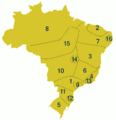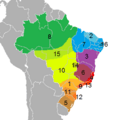Brazilian Portuguese facts for kids
Brazilian Portuguese is a special way of speaking the Portuguese language. It's mostly used in Brazil, a huge country in South America. Think of it like how American English is a bit different from British English. Brazilian Portuguese has its own unique sounds, words, and ways of putting sentences together.
About 210 million people speak Brazilian Portuguese. That's a huge number! It means most people who speak Portuguese around the world speak the Brazilian kind. While people from Brazil and Portugal can usually understand each other, there are enough differences that it can sometimes be a bit tricky.
Contents
What is Brazilian Portuguese?
Brazilian Portuguese is a dialect of the Portuguese language. It's the main language spoken in Brazil. When Portuguese explorers came to Brazil many centuries ago, they brought their language with them. Over time, as Brazil grew and developed, the language changed a bit. It picked up new words and sounds. This is how Brazilian Portuguese became different from the Portuguese spoken in Portugal.
How is Brazilian Portuguese Different?
The main differences between Brazilian Portuguese and European Portuguese are in how words are pronounced and some vocabulary. For example, Brazilians often pronounce "s" sounds differently at the end of words. They also use different words for some common things. Imagine saying "lift" instead of "elevator" or "lorry" instead of "truck." It's similar to that!
Another difference is in grammar. Sometimes, Brazilians use different verb forms or sentence structures. These small changes make the two dialects sound distinct. Even with these differences, both are still Portuguese. They share a common history and many words.
Where is Brazilian Portuguese Spoken?
Brazilian Portuguese is spoken mainly in Brazil. It is the official language of the country. Because Brazil is so large, there are even different ways of speaking Brazilian Portuguese within Brazil itself! People from the north might sound a bit different from people in the south. These are called regional accents or variants.
Portuguese is also spoken in other countries around the world. These include Portugal, Angola, Mozambique, and others. These countries are part of the Community of Portuguese Language Countries. They work together to promote the Portuguese language and culture.
Why is Brazilian Portuguese Important?
Brazilian Portuguese is important for many reasons. It is the language of a large and growing country, Brazil. Brazil is known for its vibrant culture, music, and sports. Learning about Brazilian Portuguese helps us understand this rich culture.
Many famous books, songs, and movies come from Brazil. They are all in Brazilian Portuguese. Leaders from Brazil, like presidents, often speak Portuguese when they talk to other world leaders. They use interpreters to help everyone understand. This shows how important the language is on the global stage.
Learning About the Language
There are many places where you can learn more about the Portuguese language. In São Paulo, Brazil, there is a special place called the Museum of the Portuguese Language. It's a fun and interactive museum. It helps people explore the history and beauty of the language.
Libraries like the Real Gabinete Português de Leitura in Rio de Janeiro are also great places. They have many old and new books in Portuguese. These places help keep the language alive and celebrated.
Sometimes, experts and politicians meet to discuss the Portuguese language. They talk about things like spelling rules. This helps keep the language consistent across different countries. These meetings show how much people care about the language.
Images for kids
-
Since the inauguration of the United Nations, the Brazilian president has delivered his first speech, before all the presidents of the world. The Portuguese language is spoken in the first place since the inauguration of the United Nations. In 2019, Brazilian President Bolsonaro speaks at the United Nations in Portuguese.
-
Portuguese world including Brazil, Portugal, etc.
-
Opening of the 15th Conference of Ministers of Justice of the Community of Portuguese Language Countries in 2017. Former Brazilian president Michel Temer with former Brazilian justice minister Torquato Jardim.
-
A Portuguese to English interpreter and an English to Portuguese interpreter were used at the Mar-a-Lago meeting in 2020, the official residence of U.S. President Donald Trump. In all meetings outside the Portuguese language, Brazilian President Jair Bolsonaro uses interpreters as in public he only speaks Portuguese.
-
2017 Debate on the Portuguese language in the Senate of Brazil.
-
Museum of the Portuguese Language in São Paulo.
-
2014 Interactive public hearing to debate the Portuguese Language Orthographic Agreement in Brasília.
-
Museum of the Portuguese Language in São Paulo.
-
Real Gabinete Português de Leitura in Rio de Janeiro.
-
Museum of the Portuguese Language in São Paulo.
-
Real Gabinete Português de Leitura in Salvador.
-
Bronze bust of Renaissance poet Luís de Camões in Rio de Janeiro.
-
Chandelier decorating the Real Gabinete Português de Leitura in Rio de Janeiro.
-
Museum of the Portuguese Language in São Paulo.
-
Inside the Real Gabinete Português de Leitura in Recife.
-
Entrance of the Real Gabinete Português de Leitura in Rio de Janeiro.
-
Real Gabinete Português de Leitura in Recife.
-
Inside of the Real Gabinete Português de Leitura in Rio de Janeiro.
-
Museum of the Portuguese Language in São Paulo.
-
Portals of the Real Gabinete Português de Leitura in Rio de Janeiro.
-
Entrance of the Real Gabinete Português de Leitura in Salvador.
-
1st Strategic Management Meeting of the Association of Secretaries-General of Portuguese-Speaking Parliaments of 2016, in Brasília.
-
Museum of the Portuguese Language in São Paulo.
-
Portuguese tiles in Real Gabinete Português de Leitura in Salvador.
-
Museum of the Portuguese Language in São Paulo.
-
In Brasília, the Chamber of Deputies and the Senate jointly hold the "2017 Meeting of Management, Finance and Human Resources Staff" of the Association of Secretaries-General of Portuguese-speaking Parliaments with the aim of sharing experiences and work models related to organizational and administrative management in parliaments, human resources management, planning and financial management in the legislature, among other matters relevant to the topic. The event has the presence of representatives from all Portuguese-speaking countries.
-
Statue of the Portuguese Infant Dom Henrique at the entrance of the Real Gabinete Português de Leitura in Rio de Janeiro.
-
Books on the Museum of the Portuguese Language in São Paulo.
-
Portuguese books in the Real Gabinete Português de Leitura in Rio de Janeiro.
-
Entrance of the Museum of the Portuguese Language in São Paulo.
-
Glazing in the Real Gabinete Português de Leitura in Rio de Janeiro.
-
Museum of the Portuguese Language in São Paulo.
-
Gold details in the Real Gabinete Português de Leitura in Rio de Janeiro.
-
Museum of the Portuguese Language in São Paulo.
-
Members of the First Strategic Management Meeting of the Association of Secretaries-General of Portuguese-Speaking Parliaments participate in a dinner in 2016, in Brasília.
-
Museum of the Portuguese Language in São Paulo.
-
Portuguese immigrants arriving in Rio de Janeiro.
-
Senate of Brazil committee room during a meeting of the Education, Culture and Sport Committee in 2014. The committee holds a public hearing to discuss the Orthographic Agreement for the Portuguese Language, signed in 1990 and implemented in January 2016. The new rules must apply for the eight countries that have Portuguese as an official language, including Brazil, Portugal, etc.
-
Library of the Real Gabinete Português de Leitura in Rio de Janeiro.
-
Museum of the Portuguese Language in São Paulo.
-
Real Gabinete Português de Leitura in Salvador.
-
Statue of the Portuguese Poet Luís de Camões at the entrance of the Real Gabinete Português de Leitura in Rio de Janeiro.
-
Entrance of the Real Gabinete Português de Leitura in Rio de Janeiro at night.
-
Brazilian flag and Portuguese flag in the front of the Real Gabinete Português de Leitura in Rio de Janeiro.
-
Bronze bust of Portuguese Carlos I of Portugal in Rio de Janeiro.
-
Museum of the Portuguese Language in São Paulo.
-
Internal architecture of the Real Gabinete Português de Leitura in Rio de Janeiro.
-
Bronze bust of Portuguese Eduardo Lemos in Rio de Janeiro.
-
Interior of Santa Isabel Theater in Recife.
-
Museum of the Portuguese Language in São Paulo.
-
The Senate of Brazil preserves the books that record presidential inaugurations since 1891. By signing the book, the president-elect assumes the commitment to govern the country and defend the Constitution, continuing the timeline that has been traced since February 26, 1891. Access to the two volumes is restricted in order to protect the heritage. The documents are kept in the Senate Archives, in a room with temperature, humidity and light subject to strict parameters. Organized in two volumes by the Archive Coordination, these documents testify to the historical evolution of the Portuguese language, based on elements such as the successive loss of archaisms. This cover book shows: "Term of Inauguration of the Presidents of the Republic of the United States of Brazil." When "United States" of Brazil was still used with the letter Z, and not Brasil with the letter S.
-
Portuguese descendants in Santos.
-
Variants and sociolects of Brazilian Portuguese.
-
Linguistic map of the state of Minas Gerais, according to the scientific study Esboço de um Atlas Linguístico de Minas Gerais (EALMG), "Draft of a Linguistic Atlas for Minas Gerais". Federal University of Juiz de Fora, 1977. The red zone speaks mineiro, the yellow zone caipira, the blue zone baiano.
-
Portuguese immigrants arriving in Rio de Janeiro.
-
Bust of the Portuguese Pedro Álvares Cabral in Rio de Janeiro.
-
Museum of the Portuguese Language in São Paulo.
-
Library of the Real Gabinete Português de Leitura in Rio de Janeiro.
-
Entrance of the Real Gabinete Português de Leitura in Salvador.
-
Municipal Theatre of São Paulo is a theatre in São Paulo.
-
Museum of the Portuguese Language in São Paulo.
See also
 In Spanish: Portugués brasileño para niños
In Spanish: Portugués brasileño para niños


































































